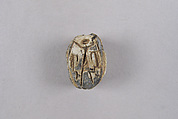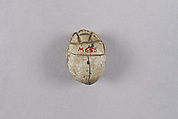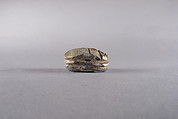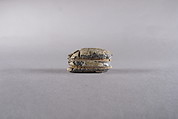Scarab with Master of the Animals Holding Crocodiles
Third Intermediate Period
A particular type of seal-amulet is found in archaeological contexts from the 10th century B.C. onwards. They are quite crudely and irregularly carved and the motifs on the underside show predominantly hunting scenes, with varied combinations of horned quadrupeds, lions, ostriches, and hunters. Based on the style of the incisions and on the large numbers that have surfaced in (northern) Egypt, but especially in the southern Levant, these seal-amulets are considered to be the result of a mass production. Their origin, however, is still under discussion. In the scholarly literature, they are labelled ‘Post-Ramesside mass-produced seal-amulets’ and are dated to the late 11th and 10th centuries B.C., that is, Dynasty 21 and early Dynasty 22 in Egypt, or the end of the Iron Age IB – early Iron Age II in the southern Levant.
This example shows a highly stylized standing figure holding a large animal on either side. Even though this scarab is badly damaged on the sides, parallels indicate that he holds two crocodiles. Such scenes are also known as ‘the master of animals,’ an ancient Near Eastern symbol that may be interpreted as [a reference to] the successful control of man over nature, or even of order over chaos.
This image cannot be enlarged, viewed at full screen, or downloaded.
This artwork is meant to be viewed from right to left. Scroll left to view more.





